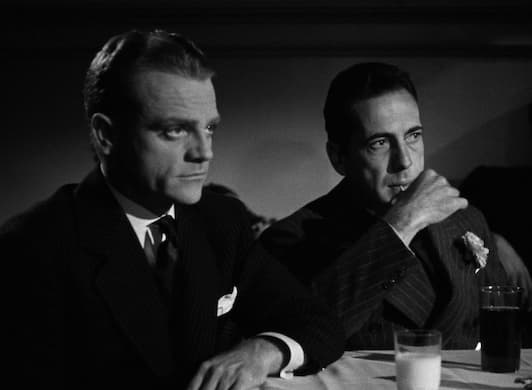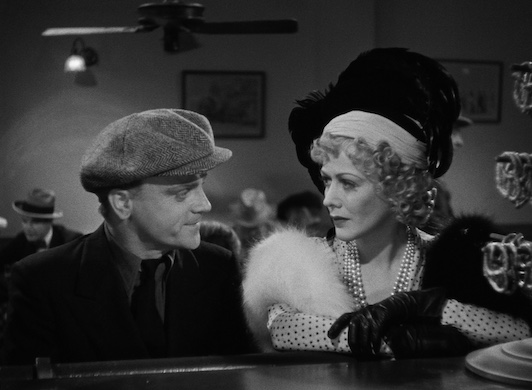Featuring Cagney and Bogart, ‘The Roaring Twenties’ Deserves Another Look
The Criterion Collection has just released a 4-K restoration of Raoul Walsh’s gangland epic on Blu-Ray and DVD.

The year 1939 is often cited as Hollywood’s finest moment, as proof positive that mercantilism (the studio system) and aesthetics (good movies) are mutually compatible. Give a casual movie-goer half a tick and he’ll come up with examples like “The Wizard of Oz” or “Gone With the Wind.” Scratch a little harder and you might hear about “Mr. Smith Goes to Washington” or “Stagecoach.” The list is long and deep.
Add “The Roaring Twenties” to this accounting. The Criterion Collection has just released a 4-K restoration of Raoul Walsh’s gangland epic on Blu-Ray and DVD. Among the extras included in the package is an interview with a former Sun critic, Gary Giddins, and audio commentary by a biblical scholar who had a soft spot for crime movies, the late Lincoln Hurst.
“If you had the two of them in the same picture,” Walsh noted when speaking about “The Roaring Twenties,” “you knew that you had good audience interest in the conclusion of this picture.” How could you not with a film that featured both James Cagney and Humphrey Bogart? “When you have a man like Jimmy Cagney in a gangster picture, he would give an approach that nobody else can handle.” Walsh’s take on Bogart ran along similar lines.
Walsh made a distinction between the film’s two stars and coevals like Clark Gable, Gary Cooper, and Gregory Peck. The latter were, for all intents and purposes, sacrosanct: the audience wouldn’t stand for their characters dying. Yet, as Walsh makes plain, “you could kill a Cagney or a Bogart and still have a successful picture.” Why might that be, do you think?

The lasting power of first contact and, with it, typecasting shouldn’t be underestimated. Although they assumed a host of non-gangster roles during their careers, both actors made splashes as bad guys: Cagney as an avaricious bootlegger in “Public Enemy” (1931), Bogart as a hoodlum-on-the-run in “The Petrified Forest” (1936). Nor did they shy from playing suspect characters as they grew older: witness Cagney’s turn as a psychotic momma’s boy in “White Heat” (1949) or Bogart’s temperamental screenwriter in “In a Lonely Place” (1951).
Cagney’s character in “The Roaring Twenties” is a variation on his role in “Public Enemy”: Walsh makes that plain when he has Eddie Bartlett crush a cigar into the face of a surly nightclub owner just like Tom Power did with a grapefruit to Mae Clarke in the earlier film. The milieu has shifted to Manhattan from Chicago and the narrative is more varied, particularly in a side-story involving Eddie’s promotion of a singer from Mineola, Jean Sherman (Priscilla Lane). Walsh’s tale of bootlegging, betrayal, and murder sometimes takes on the guise of a musical comedy.
The story follows a small cadre of veterans, primarily Bartlett and George Hally (Bogart), as they make their way in a post-war America. Stuck for any kind of work, Bartlett finds his way into bootlegging, using his wits, his muscle, and his ambition to build an empire. In a convenient plot twist, he reconnects with Hally and they partner up to thwart a local mob boss. Inconveniently, at least for Barlett, Hally resents playing second fiddle and doesn’t think twice about ratting out his associate. Honor amongst thieves is thin gruel in Walsh’s universe.
The dialogue throughout is snappy and knowing. Walsh’s direction is almost surreptitiously fluid and his handling of violence stark. Even when the story lapses in motivation or rationale, the cast is there to right the course of events. A secret ingredient is Gladys George as the world-weary, wise-cracking, and lovelorn chanteuse, Panama Smith. She and Cagney have a crisp rapport, and when Panama tells Eddie a home truth about love, Walsh focuses the camera on Cagney for an extended reaction shot that is heartbreaking in its understatement.
Which only goes to confirm Walsh’s opinion on Cagney and his singular, cocksure talent. Although “The Roaring Twenties” isn’t necessarily the best work by all those concerned, the work they’ve done in it is part-and-parcel of why movie fans treasure them. If you’re curious as to why Cagney, Bogart, Walsh, and George are big shots — that is, by the way, an insider reference for fans of the picture — this is a good place to start.

